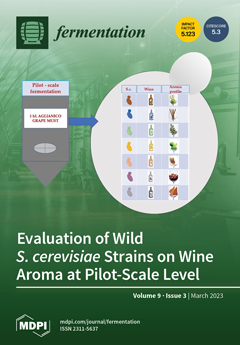Delonix regia (common name: Flame tree) pods, an inexpensive lignocellulosic waste matrix, were successfully used to produce value-added bioethanol. Initially, the potentiality of
D. regia pods as a lignocellulosic biomass was assessed by Fourier-transform infrared spectroscopy (FTIR), which revealed the presence of several
[...] Read more.
Delonix regia (common name: Flame tree) pods, an inexpensive lignocellulosic waste matrix, were successfully used to produce value-added bioethanol. Initially, the potentiality of
D. regia pods as a lignocellulosic biomass was assessed by Fourier-transform infrared spectroscopy (FTIR), which revealed the presence of several functional groups belonging to cellulose, hemicellulose, and lignin, implying that
D. regia pods could serve as an excellent lignocellulosic biomass. Response Surface Methodology (RSM) and Central Composite Design (CCD) were used to optimize pretreatment conditions of incubation time (10–70 min), H
2SO
4 concentration (0.5–3%), amount of substrate (0.02–0.22 g), and temperature (45–100 °C). Then, RSM-suggested 30 trials of pretreatment conditions experimented in the laboratory, and a trial using 0.16 g substrate, 3% H
2SO
4, 70 min incubation at 90 °C, yielded the highest amount of glucose (0.296 mg·mL
−1), and xylose (0.477 mg·mL
−1). Subsequently, the same trial conditions were chosen in the downstream process, and pretreated
D. regia pods were subjected to enzymatic hydrolysis with 5 mL of indigenously produced cellulase enzyme (74 filter per unit [FPU]) at 50 °C for 72 h to augment the yield of fermentable sugars, yielding up to 55.57 mg·mL
−1 of glucose. Finally, the released sugars were fermented to ethanol by
Saccharomyces cerevisiae, yielding a maximum of 7.771% ethanol after 72 h of incubation at 30 °C. Conclusively, this study entails the successful valorization of
D. regia pods for bioethanol production.
Full article





